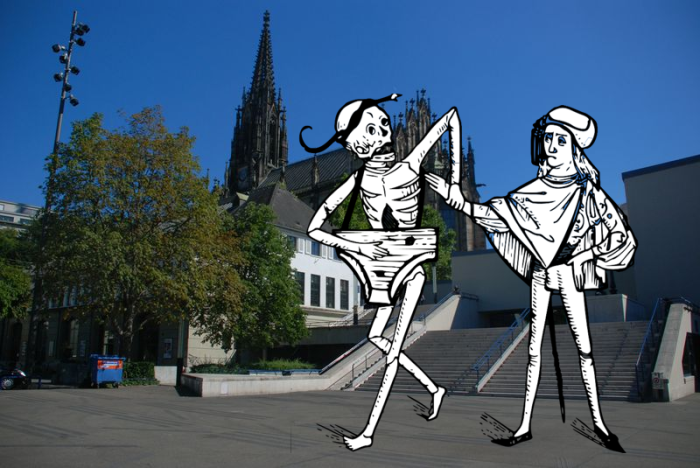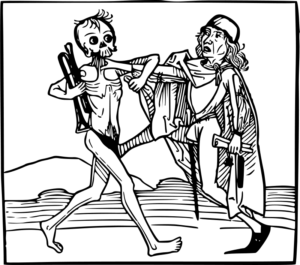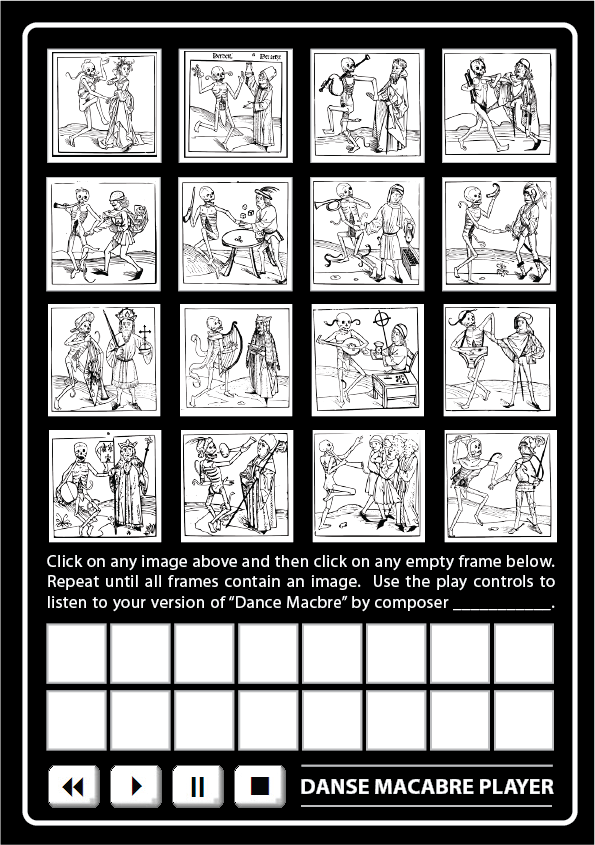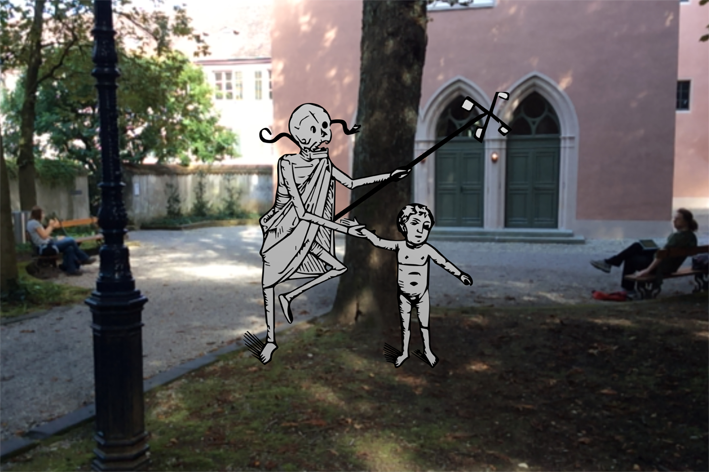
The project is about providing a music program that lets the user create a “Danse Macabre” based on a collection of music fragments that recombine into a finished piece, which can then be played back with or without accompanying animation. The project began several years ago with the interest to create an game that was more about mediating the process of music composition using the traditions interest of the past. After several years of tinkering with the idea of creating the game, various approaches were taken. The first version consisted of have the figures and music as part of an AR work that operated using geo-location triggers. The latest version is in the form of a downloadable game with which users can arrange their own versions of a set of compositions and then play it back using the imagery from the Totentanz. Although still in Beta, the game draws on the illustrations found in the “Heidelberger Totentanz”, a book containing a series of prints to the theme of Danse Macabre.
Sixteen images were taken from the collection (See Fig.1), to which 16 music fragments are linked to them. Each of the music fragments lasts from 1 to 5 seconds in length and can consist of a chord, a melody, a sustained tone or tones, or any combination of such. Each of the music fragments is played by the instrument depicted in the image -composer are open to interpret which instrument is depicted. All of them are Renaissance instruments and can be found in this document:

The interface for arranging the dance consists of three main sections. Section 1 houses the Music Matrix – a grid where the sixteen images can be seen; Section 2 houses the Score Bar – a smaller grid where chosen images from the Music Matrix are placed and when combined from the sequence of music fragments that will be played back; The third section hoses the playback controls that allow the user to listen to the arrangement made.

To arrange the dance, the user just clicks on one of the images in the Music Matrix and then places it by clicking on any one of the empty frames in the Score Bar. Clicking an empty frame in the Score Bar places the chosen image into that frame; clicking on a frame in the Space Bar that already has an image in it will replace that image with the new one. Empty bars will be ignored and are just skipped over.
Instructions to the User:
> Choose an image by click on it (the image will become “lit”)
> Chose an empty bar in the Space Bar
> Continue this ad lib until you have finished filling the Space Bar with images.
> Press the play button below the Space Bar to listen to the music.
Instructions for Composers:
In order to have some unity amongst the diverse works that will be submitted by a wide variety of composers, it was thought best to suggest composting a character work. We therefore ask or each composer to right a work under the title Dance Macabre / Totentanz. The work of course does not have any particular character outside of the one you give it as a composer. Life and Death are both good and bad and either one can reflect profound insights about existence through an array of emotional qualities reflected back to the listeners through the interpretation of the work.

In order to have some what of a challenge, the “rules” have been set to challenge the composer to provide a composition that is modular and one that can be resembled a new each time it is performer.
The Rules:
> Compose a musical fragment for each of the images given
> Fragments must be between 1 and 5 seconds in length.
> Fragments are to be composed for the instrument depicted in the image.*
> Each composer is given a key image that represents him/her.**
> Fragments can contain chords, sustained tones, melodies or combinations.
> The fragments must recombine ad lib and be independent.
> The score must be given in as notation file and as a midi file.***
* or any modern outgrowth or within the same “family” of instruments.
** Each Composer is given a “Key Image that is place in the city via GPS coordinates.
*** Composers without access to software can submit handwritten scores.
How the Application Works
The application is created to be used on an iPad or iPhone. All of the compositions are made available for playback and each can be “shuffled” into a new arrangement by the user. Each of the fragments is linked to one of the 16 images. When the images are selected from the Music Matrix and then put into the Space Bar, the music is actually being re-scored for playback purposes. When the player hits the “Play” button. The work will play back as arranged by the user. The user can start and stop the music as wished and when ready can hit the AR Button and see the Totentanz dance on the street in front of the user, When the user hits the AR button, the application switches back to the AR browser and plays the image sequence as a series of images superimposed on reality while the music plays along with the images. When the user of the application clicks on the “Key Image” (placed at a specific location in the city of Basel), the Danse Macabre Player opens and prompts the user to compose a dance.
The user has two choices when finished with the composing.
>The user can listen to the composed piece as wanted by simply pressing play
>The user can click into the AR mode and watch an animation accompanied by the composed dance.

Click here to view a demo video of the beta version of the game: